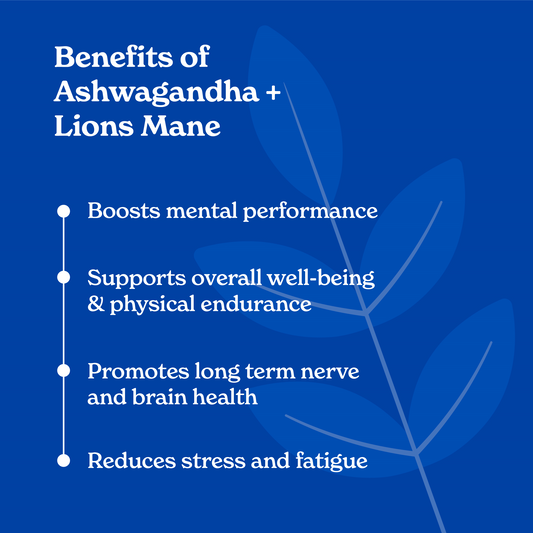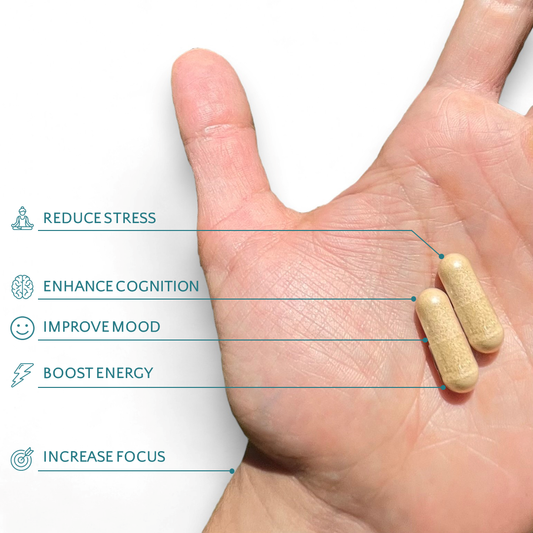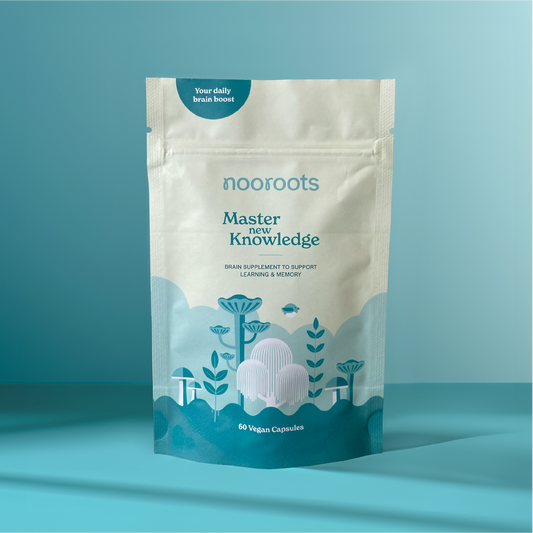The pursuit of enhanced cognition has deep roots in human history. Across civilizations, thinkers and healers have long sought ways to sharpen the mind, sustain alertness, and improve memory.
In ancient Greece, philosophers used herbs such as rosemary to promote mental clarity and recall. Similarly, in traditional Chinese and Ayurvedic medicine, botanicals like Panax ginseng and Bacopa monnieri were valued for their reputed cognitive and adaptogenic effects. During the Middle Ages, alchemists experimented with tonics and elixirs to strengthen both mind and body—early echoes of today’s cognitive enhancers.
The modern scientific understanding of these pursuits emerged in the 20th century, when Romanian psychologist and chemist Dr. Corneliu E. Giurgea coined the term “nootropic” in 1972 to describe compounds that could enhance learning and memory while remaining remarkably safe and non-addictive. Since then, research has broadened to include both synthetic compounds (such as piracetam) and naturally derived agents that aim to improve cognition and brain health.
While stimulants like caffeine or amphetamines act more immediately on the central nervous system to heighten alertness and focus, nootropics are designed to support cognition more subtly and sustainably.
This blog explores how these two categories—nootropics and stimulants—differ in their mechanisms, effects, and applications, and how understanding those differences can guide smarter approaches to cognitive enhancement.
Contents
- An Overview of Nootropics vs. Stimulants
- Are Nootropics Stimulants?
- The Effects of Nootropics on Focus and Concentration
- Synthetic Nootropics for Focus and Concentration
- Common Stimulant Substances
- Risks of Taking Synthetic Nootropics for Focus and Concentration
- Comparison of Nootropics And Stimulants for Focus And Concentration
Sharpening the mind: A look at Nootropics vs. Stimulants for Improved Focus and Concentration

An Overview of Nootropics vs. Stimulants
What are Nootropics and How Do They Work?
Nootropics are compounds intended to support cognition without strong excitatory effects. Rather than “amping up” the nervous system, they tend to fine-tune processes that underlie learning, memory, and mental clarity.
Common pathways include:
- Supporting neurotransmitters – helping key brain chemicals involved in learning, focus, and memory work more efficiently.
- Improving blood flow and oxygen delivery – ensuring the brain gets the energy and nutrients it needs for sustained performance.
- Protecting brain cells – reducing oxidative stress and damage from low oxygen or metabolic strain.
- Enhancing resilience – helping the body and mind cope better with stress, fatigue, and mental overload.
Overall, their effects are typically subtle and cumulative, with a safety profile that allows for sustained use when appropriately selected.
What are Stimulants and How Do They Work?
Stimulants are a distinct class of compounds that increase alertness, energy, and focus by enhancing the activity of key neurotransmitters in the central nervous system, particularly dopamine and norepinephrine.
Medically, stimulants are prescribed for conditions such as Attention Deficit Hyperactivity Disorder (ADHD) and narcolepsy, where they help regulate attention and wakefulness. Common examples include methylphenidate, amphetamine derivatives, modafinil, and caffeine.
Mechanistically, stimulants work by blocking the reuptake or increasing the release of dopamine and norepinephrine in the brain. This results in amplified neural signaling, producing effects such as:
- Improved attention and motivation
- Increased energy and alertness
- Reduced fatigue
However, stimulants can also produce side effects, including increased heart rate, anxiety, irritability, and sleep disturbances, especially when misused or taken in high doses. Long-term or unsupervised use carries a risk of tolerance, dependence, and withdrawal.
Despite these risks, when used responsibly under medical supervision, stimulants remain among the most effective treatments for attention and wakefulness disorders.
Are Nootropics Stimulants?
Nootropics and stimulants both influence cognition but differ in mechanism and safety. Stimulants boost central nervous system activity for rapid alertness, while nootropics enhance brain function through balanced, long-term support.
Nootropics are low in toxicity, non-addictive, and promote stable cognitive performance without agitation or overstimulation. Any mild energizing effects stem from improved neural efficiency, not direct excitation.
Stimulants elevate dopamine and norepinephrine for short bursts of focus and energy but can lead to dependence and fatigue with repeated use.
In short, nootropics are not stimulants—they optimize cognition sustainably rather than amplify activity.
The Effects of Nootropics on Focus and Concentration
The pursuit of sharper focus and sustained concentration has driven growing interest in nootropics. Below is an overview of several well-studied nootropics, their origins, mechanisms, and evidence-based roles in supporting mental focus and concentration.
Common Nootropic Substances
Guarana Seed
- Origin: Native to the Amazon basin, guarana seeds are rich in naturally occurring caffeine.
- Mechanism: The caffeine content in guarana blocks adenosine receptors in the brain, reducing fatigue and promoting wakefulness. Some studies suggest its effects extend beyond caffeine alone, possibly due to synergistic plant compounds such as tannins and saponins.
- Benefits: Guarana may enhance mental alertness, reaction time, and sustained attention, particularly during prolonged cognitive tasks.
L-Theanine
- Origin: An amino acid primarily found in Camellia sinensis (green tea) leaves.
- Mechanism: L-theanine promotes relaxation without sedation by modulating neurotransmitters, including GABA, dopamine, and serotonin, and by influencing alpha brain wave activity associated with a calm yet alert state.
- Benefits: When combined with caffeine, L-theanine has been shown to improve attention and focus while reducing jitteriness and mental fatigue, supporting a balanced cognitive state.
Acetyl-L-Carnitine (ALCAR)
- Origin: A naturally occurring derivative of the amino acid L-carnitine, found in red meats and synthesized in the body.
- Mechanism: ALCAR facilitates fatty acid transport into mitochondria, enhancing cellular energy metabolism and offering neuroprotective effects through antioxidant activity.
- Benefits: Evidence suggests ALCAR supports mental energy, concentration, and memory, with additional benefits in age-related cognitive decline.
Ginkgo Biloba
- Origin: Extracted from the leaves of the ancient ginkgo tree, long used in traditional Chinese medicine.
- Mechanism: Ginkgo enhances cerebral blood flow and modulates neurotransmission while providing antioxidant protection against oxidative stress.
- Benefits: Supplementation has been associated with improvements in working memory, attention, and processing speed, particularly in older adults or individuals with mild cognitive impairment.
Rhodiola Rosea
- Origin: A flowering plant native to cold, mountainous regions of Europe and Asia.
- Mechanism: Rhodiola acts as an adaptogen, helping regulate the hypothalamic–pituitary–adrenal (HPA) axis and balance stress-related neurotransmitters such as serotonin and dopamine.
- Benefits: It may enhance mental clarity, reduce fatigue, and improve focus—especially under stress or during periods of high mental demand.
Bacopa Monnieri
- Origin: A creeping herb used in Ayurvedic medicine for centuries as a memory tonic.
- Mechanism: Bacopa enhances synaptic communication and neuronal repair by modulating cholinergic transmission and promoting dendritic growth.
- Benefits: Clinical studies suggest Bacopa improves memory retention, learning capacity, and attention span, with additional anxiolytic effects that support mental calmness during cognitive effort.
Citicoline (CDP-Choline)
- Origin: A creeping herb used in Ayurvedic medicine for centuries as a memory tonic.
- Mechanism: Bacopa enhances synaptic communication and neuronal repair by modulating cholinergic transmission and promoting dendritic growth.
- Benefits: Clinical studies suggest Bacopa improves memory retention, learning capacity, and attention span, with additional anxiolytic effects that support mental calmness during cognitive effort.
N-Acetyl L-Tyrosine (NALT)
- Origin: A more bioavailable form of the amino acid tyrosine, found in high-protein foods.
- Mechanism: NALT serves as a precursor for catecholamine neurotransmitters—dopamine, norepinephrine, and epinephrine—critical for maintaining cognitive performance under stress.
- Benefits: Supplementation may enhance working memory, mental resilience, and task focus, particularly during periods of sleep deprivation or acute stress.
Synthetic Nootropics for Focus and Concentration
Synthetic nootropics are laboratory-developed compounds designed to enhance focus, attention, and mental performance through targeted effects on neurotransmission and brain metabolism. Below is an overview of key synthetic nootropics that have been investigated for their role in supporting cognitive function.
Piracetam
- Overview: A cyclic derivative of gamma-aminobutyric acid (GABA), piracetam was the first compound classified as a nootropic.
- Mechanism: Enhances acetylcholine activity at muscarinic receptors, modulates NMDA receptor function, and improves neuronal membrane fluidity and oxygen utilization.
- Benefits: Supports learning, memory, and interhemispheric communication. Used in clinical contexts for post-injury cognitive dysfunction and age-related decline, though evidence for Alzheimer’s disease remains mixed.
Modafinil
- Overview: A synthetic wakefulness-promoting compound developed in the 1970s for narcolepsy treatment.
- Mechanism: Inhibits dopamine reuptake and influences norepinephrine, serotonin, and orexin pathways, improving alertness and executive function.
- Benefits: Enhances wakefulness and cognitive performance in sleep-deprived individuals; may improve attention and working memory in healthy subjects.
Adderall/Ritalin (Amphetamine/Dextroamphetamine & Methylphenidate)
- Overview: Central nervous system stimulants widely prescribed for ADHD and narcolepsy.
- Mechanism: Increase dopamine and norepinephrine availability by blocking reuptake and enhancing release, improving attention and impulse control.
- Benefits: Clinically proven to enhance concentration and focus in ADHD patients. Off-label use in healthy individuals is controversial due to side-effect and dependency risks.
Noopept
- Overview: A peptide-based nootropic developed as a more potent analogue of piracetam.
- Mechanism: Elevates brain-derived neurotrophic factor (BDNF) and nerve growth factor (NGF), supporting synaptic plasticity and learning.
- Benefits: Shown to enhance memory and cognitive recovery following injury or impairment; may offer neuroprotective benefits.
Phenylpiracetam
- Overview: A phenylated analogue of piracetam designed for greater potency and bioavailability.
- Mechanism: Similar to piracetam, but with additional stimulant-like activity attributed to the phenyl group, enhancing both mental and physical performance.
- Benefits: Improves focus, memory, and reaction time; may increase tolerance to cold and stress-related fatigue.
Armodafinil
- Overview: The R-enantiomer of modafinil, offering greater potency and a longer half-life.
- Mechanism: Similar to modafinil, armodafinil elevates extracellular dopamine by inhibiting reuptake, promoting sustained alertness and mental clarity.
- Benefits: Provides extended wakefulness and concentration, particularly for shift workers and individuals with sleep disorders.
Sulbutiamine
- Overview: A synthetic derivative of vitamin B1 (thiamine) designed for improved penetration of the blood–brain barrier.
- Mechanism: Enhances cholinergic and dopaminergic neurotransmission, increasing thiamine-dependent enzyme activity essential for neuronal energy metabolism.
- Benefits: Improves alertness, memory, and fatigue resistance; supports cognitive performance without the overstimulation associated with amphetamines.
Sunifiram
- Overview: A potent ampakine-like compound structurally related to piracetam, though with significantly higher activity.
- Mechanism: Modulates glutamatergic and cholinergic pathways, enhancing long-term potentiation (LTP) and synaptic plasticity critical for learning and memory.
- Benefits: Preliminary studies suggest improvements in attention, learning, and memory formation with minimal side effects, though human research remains limited.
Common Stimulant Substances
Stimulants are compounds that increase central nervous system activity, leading to greater alertness, energy, and focus. Below is an overview of widely known stimulants and their principal characteristics.
Caffeine
- Overview: A naturally occurring alkaloid found in coffee, tea, cocoa, and kola nuts.
- Mechanism: Blocks adenosine receptors in the brain, preventing drowsiness and promoting wakefulness.
- Benefits: Enhances focus, alertness, and reaction time; may reduce perceived effort during physical and mental tasks.
Amphetamines (Example: d-amphetamine)
- Overview: Synthetic compounds first developed in the late 19th century; used medically to treat ADHD and narcolepsy.
- Mechanism: Increase synaptic levels of dopamine and norepinephrine by promoting release and inhibiting reuptake.
- Benefits: Improve attention, concentration, and mental energy; support behavioral control in ADHD. However, misuse carries a significant risk of dependence and cardiovascular side effects.
Nicotine
- Overview: A plant-derived alkaloid found primarily in Nicotiana tabacum (tobacco).
- Mechanism: Stimulates nicotinic acetylcholine receptors, influencing the release of dopamine and other neurotransmitters.
- Benefits: May transiently enhance memory, attention, and cognitive performance, though habitual use leads to receptor desensitization, addiction, and health risks.
Prescription Stimulants
- Overview: Medications including methylphenidate and mixed amphetamine salts, prescribed for ADHD and sleep disorders.
- Mechanism: Increase dopamine and norepinephrine activity in the brain, improving signal transmission within attention and motivation networks.
- Benefits: Clinically effective for improving focus, wakefulness, and impulse control in diagnosed individuals. Non-prescribed use is associated with heightened risk of dependency and adverse cardiovascular or psychiatric effects.
Ephedrine
- Overview: A naturally derived alkaloid from the Ephedra plant, historically used as a bronchodilator and stimulant.
- Mechanism: Increases norepinephrine release and activates adrenergic receptors, leading to heightened alertness and energy.
- Benefits: Enhances focus and physical performance but may raise heart rate and blood pressure; regulated due to its potent stimulant properties.
While stimulants can significantly enhance focus and cognitive performance, their risk–benefit profile varies depending on potency, mechanism, and medical oversight. Therapeutic agents such as caffeine, modafinil, and prescribed amphetamines can be effective and generally safe when used under professional supervision. However, unsupervised or excessive use of potent stimulants carries clear risks, including tolerance, dependence, and cardiovascular strain.
Risks of Taking Synthetic Nootropics for Focus and Concentration
Synthetic nootropics such as Phenylpiracetam, Noopept, Sunifiram, Adrafinil, and Sulbutiamine are often promoted for their ability to enhance focus, mental clarity, and productivity.
Their appeal lies in the promise of rapid cognitive improvement—sometimes without requiring a prescription.
However, these compounds are pharmacologically active substances, and their use carries measurable risks that warrant careful consideration.
Understanding the Risks
While synthetic nootropics can provide short-term improvements in concentration and cognitive endurance, their safety profiles vary widely, and long-term effects remain insufficiently studied. The most significant concerns include:
- Side Effects: Compounds such as Phenylpiracetam and Noopept have been associated with mild to moderate side effects, including headaches, nausea, irritability, and dizziness. These reactions are often dose-dependent and may indicate overstimulation or neurotransmitter imbalance. In rare cases, users report anxiety or insomnia, especially when taken late in the day.
- Drug Interactions: Certain synthetic nootropics—particularly Adrafinil and Sulbutiamine—can interact with prescription medications such as antidepressants, anxiolytics, and blood pressure drugs. These interactions may amplify or inhibit pharmacological effects, potentially leading to cardiovascular strain or altered mood regulation. Medical supervision is essential when combining nootropics with other treatments.
- Tolerance and Dependence: Repeated use of compounds like Sunifiram and Adrafinil can lead to tolerance, reducing their effectiveness over time and prompting users to increase dosages. Escalating intake raises the risk of dependence, sleep disruption, and impaired mood stability. Unlike classic stimulants, these effects are less predictable and not well-characterized in long-term human trials.
- Legal and Regulatory Uncertainty: Many synthetic nootropics—including Phenylpiracetam and Noopept—are not approved by the U.S. Food and Drug Administration (FDA) for any medical use. This lack of regulation means product purity, dosing accuracy, and formulation consistency cannot be guaranteed. Unverified or mislabeled products increase the likelihood of contamination, underdosing, or unlisted active ingredients.

Comparison of Nootropics And Stimulants for Focus And Concentration
Both nootropics and stimulants are used to enhance focus, attention, and cognitive performance, yet they differ fundamentally in mechanism, duration of action, and risk profile. Understanding these distinctions is essential when choosing between sustainable cognitive support and short-term performance enhancement.
Advantages and Disadvantages
Nootropics:
Advantages
- Safety and Tolerability: Most nootropics are well-tolerated and non-addictive. They do not typically cause overstimulation, anxiety, or depletion of the body’s functional reserves.
- Sustained Cognitive Support: Nootropics enhance neuroplasticity, cerebral metabolism, and neurotransmitter balance, contributing to gradual and long-term improvements in focus, memory, and learning.
- Neuroprotective Effects: Some compounds provide protection against oxidative stress and age-related cognitive decline, supporting overall brain health.
Disadvantages
- Gradual Onset: Benefits typically accumulate with consistent use, meaning noticeable effects may take days or weeks to appear.
- Individual Variability: Response rates differ widely among users due to genetic, metabolic, and lifestyle factors.
Stimulants:
Advantages
- Rapid Effects: Stimulants deliver immediate increases in alertness, motivation, and concentration, making them effective for acute cognitive demands.
- Extensive Research: Compounds such as caffeine, modafinil, and amphetamines are well-characterized, providing reliable short-term outcomes and predictable dosing parameters.
Disadvantages
- Potential for Dependence: Many stimulants carry a risk of tolerance and addiction with prolonged or unsupervised use.
- Physiological Side Effects: Elevated heart rate, anxiety, and insomnia are common, particularly with high doses or chronic use.
- Short Duration: The effects of most stimulants wear off quickly, sometimes followed by rebound fatigue or irritability.
Choosing Between Nootropics and Stimulants
Personal Objectives
Those seeking sustainable cognitive maintenance—including memory support, learning efficiency, and long-term focus—may find nootropics more suitable. Conversely, individuals requiring short-term enhancement for high-pressure tasks or fatigue management may benefit from stimulants.
Risk Tolerance
Users sensitive to overstimulation or concerned about dependency should prioritize nootropics for their safer pharmacological profile. Stimulants, though effective, require greater caution due to their impact on neurotransmitter systems and the potential for misuse.
Frequency of Use
Nootropics are best suited for consistent, daily supplementation to achieve cumulative benefits. Stimulants are more appropriate for occasional or situational use when rapid performance improvement is needed.
Health Considerations
Individuals with cardiovascular issues, hypertension, or anxiety should avoid potent stimulants. Nootropics, with their milder systemic effects, are generally better tolerated in such cases—though medical consultation remains essential before use.
Conclusion
Both nootropics and stimulants can enhance focus and concentration, but they operate through distinct mechanisms and carry different implications for long-term use. Understanding these differences is critical for making informed, responsible choices about cognitive enhancement.
Nootropics support brain health through gradual and sustainable mechanisms—improving neuronal communication, cerebral metabolism, and resilience to stress. They are generally well-tolerated and non-addictive, but their benefits emerge over time rather than immediately.
Stimulants, by contrast, deliver fast and noticeable improvements in alertness, energy, and task engagement. However, their effects are transient, and repeated or unsupervised use can lead to side effects such as insomnia, anxiety, cardiovascular strain, or dependency.
Choosing between these two categories depends on individual goals, health profile, and risk tolerance:
- For those seeking long-term cognitive support and neuroprotection, nootropics offer a safer and steadier approach.
- For short-term performance demands, such as extended work or study sessions, stimulants can be effective when used judiciously and under medical supervision.
Ultimately, cognitive enhancement should be approached with informed caution and balance. Sustainable performance relies not only on pharmacological aids but also on sleep quality, nutrition, stress management, and consistent mental engagement. The goal is not simply to increase output but to maintain clarity, health, and cognitive longevity over time.
For those interested in taking the first step, our Learning & Memory Nootropic Supplement at Nooroots offers a carefully formulated introduction to the world of cognitive enhancement—crafted to support both clarity of mind and balance of mood.
Continue exploring the science of smarter nutrition with these related reads:
References
- Bloemendaal, M., Froböse, M. I., Wegman, J., Zandbelt, B. B., Van De Rest, O., Cools, R., & Aarts, E. (2018). Neuro-Cognitive effects of acute tyrosine administration on reactive and proactive response inhibition in healthy older adults. ENeuro, 5(2), ENEURO.0035-17.2018. https://doi.org/10.1523/eneuro.0035-17.2018
- Bruce, S. E., Werner, K., Preston, B. F., & Baker, L. (2014). Improvements in concentration, working memory and sustained attention following consumption of a natural citicoline–caffeine beverage. International Journal of Food Sciences and Nutrition, 65(8), 1003–1007. https://doi.org/10.3109/09637486.2014.940286
- Chan, B., Freeman, M., Ayers, C., Korthuis, P. T., Paynter, R., Kondo, K., & Kansagara, D. (2020). A systematic review and meta-analysis of medications for stimulant use disorders in patients with co-occurring opioid use disorders. Drug and Alcohol Dependence, 216, 108193. https://doi.org/10.1016/j.drugalcdep.2020.108193
- Chen, N., Yang, M., Zhou, M., Xiao, J., Guo, J., & He, L. (2017). L-carnitine for cognitive enhancement in people without cognitive impairment. The Cochrane Library, 2017(3). https://doi.org/10.1002/14651858.cd009374.pub3
- Dighriri, I. M., Alsubaie, A. M., Hakami, F. M., Hamithi, D., Alshekh, M. M., Khobrani, F. A., Dalak, F. E., Hakami, A. A., Alsueaadi, E. H., Alsaawi, L. S., Alshammari, S. F., Alqahtani, A. S., Alawi, I. A., Aljuaid, A. A., & Tawhari, M. Q. (2022). Effects of omega-3 polyunsaturated fatty acids on brain functions: a systematic review. Cureus. https://doi.org/10.7759/cureus.30091
- Dove Press. (2007, July 15). Mechanisms of modafinil: A review of current research. NDT. https://www.dovepress.com/articles.php?article_id=911
- Fang, Y., Qiu, Z., Hu, W., Yang, J., Yi, X., Huang, L., & Zhang, S. (2013). Effect of piracetam on the cognitive performance of patients undergoing coronary bypass surgery: A meta-analysis. Experimental and Therapeutic Medicine, 7(2), 429–434. https://doi.org/10.3892/etm.2013.1425
- Fillmore, M. T., Kelly, T. C., & Martin, C. A. (2005). Effects of d-amphetamine in human models of information processing and inhibitory control. Drug and Alcohol Dependence, 77(2), 151–159. https://doi.org/10.1016/j.drugalcdep.2004.07.013
- Hack, B., Penna, E. M., Talik, T., Chandrashekhar, R., & Millard‐Stafford, M. (2023). Effect of Guarana (Paullinia cupana) on Cognitive Performance: A Systematic Review and Meta-Analysis. Nutrients, 15(2), 434. https://doi.org/10.3390/nu15020434
- Humphreys, K. L., Eng, T., & Lee, S. S. (2013). Stimulant medication and substance use outcomes. JAMA Psychiatry, 70(7), 740. https://doi.org/10.1001/jamapsychiatry.2013.1273
- Li, I., Lee, L., Tsai-Teng, T., Chen, W., Chen, Y., Shiao, Y., & Chen, C. (2018). Neurohealth Properties ofHericium erinaceusMycelia Enriched with Erinacines. Behavioural Neurology, 2018, 1–10. https://doi.org/10.1155/2018/5802634
- Mereu, M., Bonci, A., Newman, A. H., & Tanda, G. (2013). The neurobiology of modafinil as an enhancer of cognitive performance and a potential treatment for substance use disorders. Psychopharmacology, 229(3), 415–434. https://doi.org/10.1007/s00213-013-3232-4
- Nobre, A. C., Rao, A., & Owen, G. (2008). L-theanine, a natural constituent in tea, and its effect on mental state. PubMed, 17 Suppl 1, 167–168. https://pubmed.ncbi.nlm.nih.gov/18296328
- Peth-Nui, T., Wattanathorn, J., Muchimapura, S., Tong-Un, T., Piyavhatkul, N., Rangseekajee, P., Ingkaninan, K., & Vittaya-Areekul, S. (2012). Effects of 12-WeekBacopa MonnieriConsumption on attention, cognitive processing, working memory, and functions of both cholinergic and monoaminergic systems in healthy elderly volunteers. Evidence-based Complementary and Alternative Medicine, 2012, 1–10. https://doi.org/10.1155/2012/606424
- Stojcheva, E. I., & Quintela, J. C. (2022). The Effectiveness of Rhodiola rosea L. Preparations in Alleviating Various Aspects of Life-Stress Symptoms and Stress-Induced Conditions—Encouraging Clinical Evidence. Molecules, 27(12), 3902. https://doi.org/10.3390/molecules27123902
- Stough, C., Clarke, J., Lloyd, J., & Nathan, P. J. (2001). Neuropsychological changes after 30-day Ginkgo biloba administration in healthy participants. The International Journal of Neuropsychopharmacology, 4(02). https://doi.org/10.1017/s1461145701002292
- Воронина, Т. А. (2023). Cognitive Impairment and nootropic Drugs: mechanism of action and spectrum of effects. Neurochemical Journal, 17(2), 180–188. https://doi.org/10.1134/s1819712423020198
- Vakhitova YV, Sadovnikov SV, Borisevich SS, Ostrovskaya RU, A Gudasheva T, Seredenin SB. Molecular Mechanism Underlying the Action of Substituted Pro-Gly Dipeptide Noopept. Acta Naturae. 2016 Jan-Mar;8(1):82-9. PMID: 27099787; PMCID: PMC4837574.







